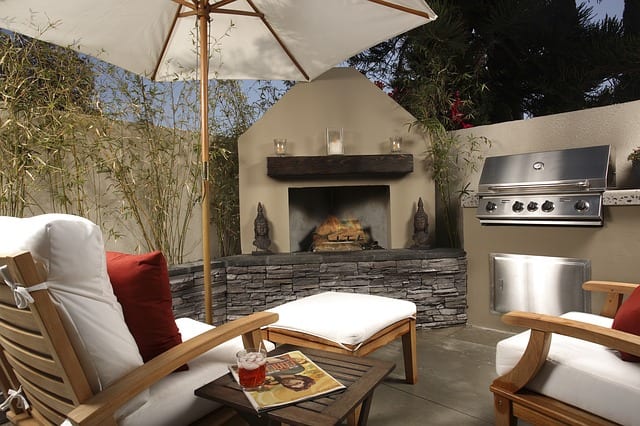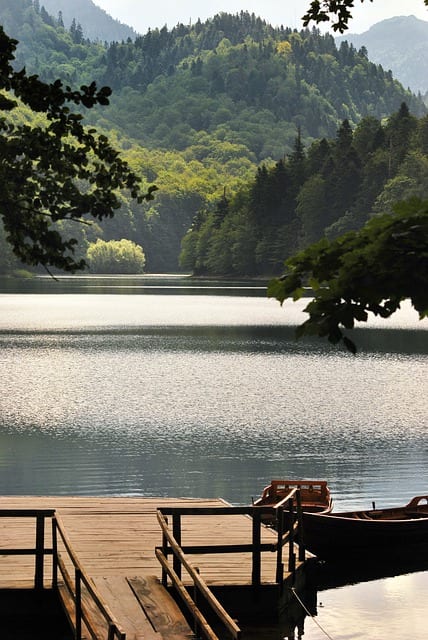
Outdoor room planning can be insanely overwhelming.
Why that is so may not be evident.
Finding the sweet spot that works for you requires doing the one thing people naturally resist: Letting go.
Human beings are wired to take control and put everything in order.
That’s what architectural landscape design is all about. It’s placing a hand on Nature to make it work for a particular property and the people that inhabit or visit it.
The challenge is finding the right balance of open and closed, light and dark, cool and warm, and wet and dry, to name a few considerations.
#1. Play With Freedom And Control To Find The Right Balance
Closing a space gives you control. Opening it transforms it with fresh light, sounds, smells, and a host of other environmental influences.
Finding the right balance goes well beyond the specific landscape elements you may use. That comes later. First, start with a vision of the space.
What do you want to see, feel, and do when you experience it?
The answer to this question will help you get a sense of what activities are most important to you.
Now use them to sketch out when, where and how you will best experience them in your outdoor room.
As you are doing that, consider the size of your space.
In many circumstances, it will be necessary to subdivide a large space into smaller rooms. These rooms may not have walls, but they will be separated by either visual or physical dividers.
Consideration should be given to the transitions between these spaces.
For example, it may be convenient to locate your outdoor grill close to the door to your home. However, the activity, heat, and smoke will be quite inconvenient for family and guests that also have to pass through that transitional space.
Think about it this way. You wouldn’t locate your kitchen adjacent to the front door to your home, would you?
The transition from your home to your outdoor room is its front door. You want that space to be open and uncluttered to allow everyone to come and go freely.
Just as the kitchen inside the home is typically located in the back of the house, so should it be for your outdoor space kitchen. If that doesn’t work for other reasons, then off to the side would be a logical compromise.
Now you are getting an idea of activities and where they make the most sense.
#2. Prioritize The Elements That Excite Your Senses
Planning and designing outdoor rooms is like a colossal puzzle. It’s a seemingly endless string of discoveries that you have to unpack and prioritize.
To do that, think about all of your senses and what will impact them, whether that is favorably or not. The sun is warm and relaxing on a cool spring morning, but it can be intolerable on a hot summer afternoon.
Here’s a short list of control variables to stimulate your thought process, starting with the space that you are planning. If you’ve owned a convertible automobile you know there’s nothing like it, but only when the conditions are right.
Find that middle ground that works for you, keeping in mind that there is is not right or wrong.
- Space – Open and closed
- Light – Light, dark, and shadows
- Sounds – Highs and lows
- Views – Seeing and being seen
- Air – Cool, hot, breezy, and stagnant
- Earth – Wet, buggy, fragrant, green, and colorful

You have to give up some control. Sometimes the greatest aspects of experiencing Nature are the unpredictable surprises that excite the senses.
Life would be very boring if it didn’t change. If the temperature and light and humidity and organization were 100% predictable, then what?
It would feel like a prison.
#3. Take Risks You Can Live With
If you are a person that normally takes big risks, then you may want to dial it back a little for this project because an outdoor room is a significant investment.
Too much risk may produce outcomes that are not recoverable, such as a massive pond that hurts the property’s resale value. Conversely, if you are usually conservative, try to go beyond your comfort zone to give your project at least one distinctive feature.
Planning minimizes mistakes.
If you are unsure of your plan give it more time. Go back to where you started, with what you want to see, feel, and do in that space.
Also, be clear about your priorities and be willing to reorganize them.
Taking a nap on a nice cozy hammock may at first seem like heaven until you realize there can be barking dogs and other sounds that will compromise the experience.
Only you will know what’s important. Is it fresh air and privacy or a more open concept of letting it all in, sun, air, water, fragrances, and sounds?
The best advice is often to experience the space in as many ways as you can before making improvements. Take a chair out there and just watch the world go by.
This is what the Feng Shui masters did. They would simply meditate on a space to feel its energy, taking in everything before building their plans.
Remember, this is your space and you have the freedom to do anything, like a kid at home alone for the evening with the run of the house!
That freedom and your genius plan are everything you need to create a remarkable outdoor room.
